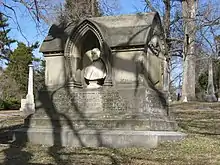Charles Pettit McIlvaine
Charles Pettit McIlvaine (January 18, 1799 – March 13, 1873)[1] was an Episcopal bishop, author, educator and twice Chaplain of the United States Senate.[2]
The Right Reverend Charles Pettit McIlvaine D.D., D.C.L., LL.D. | |
|---|---|
| Bishop of Ohio | |
 | |
| Church | Episcopal Church |
| Diocese | Ohio |
| Elected | September 7, 1832 |
| In office | 1832–1873 |
| Predecessor | Philander Chase |
| Successor | Gregory T. Bedell |
| Orders | |
| Ordination | March 20, 1821 by William White |
| Consecration | October 31, 1832 by William White |
| Personal details | |
| Born | January 18, 1799 Burlington, New Jersey, United States |
| Died | March 13, 1873 (aged 74) Florence, Kingdom of Italy |
| Buried | Spring Grove Cemetery |
| Nationality | American |
| Denomination | Anglican |
| Parents | Joseph McIlvaine & Maria Reed |
| Spouse |
Emily Coxe (m. 1822) |
| Children | 4 |
| Alma mater | Princeton University |
| Signature | |
Early life and family
McIlvaine was born on January 18, 1799, in Burlington, New Jersey to Joseph McIlvaine (later United States Senator from New Jersey) and Maria Reed (daughter of Bowes Reed, the Secretary of State of New Jersey, and niece of Joseph Reed, Continental Congressman and Governor of Pennsylvania). His father was of Scottish origin, from the MacIlvaines of Ayrshire.[2]
McIlvaine was educated at Burlington Academy and entered the College of New Jersey (later Princeton University), where he graduated in 1816. The following year, he entered the theological seminary attached to the First Presbyterian Church of Princeton.[2]
Career
In 1820 he was ordained to the diaconate in Philadelphia, and was soon after called to Christ Church in Georgetown, Washington, D.C. In 1822 he was appointed chaplain to the U.S. Senate.[2]
From 1825 to 1827, McIlvaine served as chaplain and professor of ethics at the United States Military Academy at West Point, where his students included Robert E. Lee and Jefferson Davis.[2]
In 1827 McIlvaine declined the presidency of The College of William & Mary but accepted a call to St. Ann's Church in Brooklyn, New York. In 1831 he was named professor of the evidences of revealed religion at the University of the City of New York.[2]
In 1832, he became the 2nd president of Kenyon College in Gambier, Ohio, and also the second Bishop of Ohio.[3]
He was a leading advocate of Evangelicalism, and wrote a noted rebuttal of the Oxford Movement, Oxford Divinity Compared with That of the Romish and Anglican Churches.[3] [4]
He was the 28th bishop consecrated in The Episcopal Church.
Bishop McIlvaine was so highly respected internationally (for his opposition to the Catholic-leaning Oxford movement within the Episcopal Church) that, shortly after the outbreak of the Civil War, President Lincoln asked him to go to England with Archbishop Hughes and Peter Force to argue against British recognition of the Confederacy. He often had coffee at Buckingham Palace, lunched with faculty members at Oxford, conversed with cabinet members, and influenced debate in the House of Commons.

Death
McIlvaine died in Florence, Italy on March 13, 1873.[5][2][6] His body, carried through England on its journey home to Ohio, was honored for four days in Westminster Abbey, the only American to this day to lie-in-state at Westminster.
References
- "McIlvaine, Charles Pettit". The Episcopal Church. Retrieved January 28, 2023.
- National Cyclopaedia of American Biography, Vol. 7. James T. White. 1897. p. 2. Retrieved January 30, 2021 – via Google Books.
- The Last Page Archived September 3, 2006, at the Wayback Machine – Kenyon alumni bulletin has a succession of early college presidents. Retrieved on November 21, 2006
- "Kenyon College History—The Church of the Holy Spirit", Perry Lentz, written for The Anglican Digest, January 1997. Retrieved on November 22, 2006.
- The Living Church Annual, 1944, pg. 376–377
- "Right Rev. Charles Pettis McIlvaine". The New York Times. March 15, 1873.
External links
- Bibliographic directory from Project Canterbury
- McIlvaine, Charles Pettit (1861). The evidences of Christianity; in their external, or historical, division: exhibited in a course of lectures. Philadelphia: Smith, English, and Company. Retrieved from http://www.hti.umich.edu/cgi/t/text/text-idx?c=moa;idno=AJF6316.0001.001 on August 5, 2006.